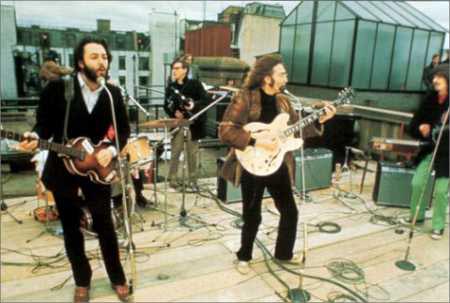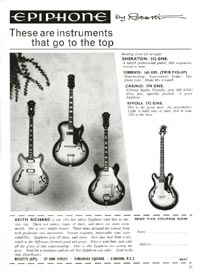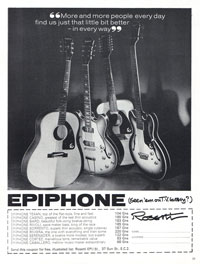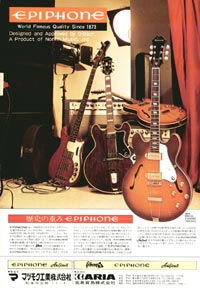
 A vintage Epiphone Casino from 1967, Cherry finish - E230TDC.
A vintage Epiphone Casino from 1967, Cherry finish - E230TDC.The Epiphone range of the 1960s consisted of several guitars based on the pre-Gibson Stathopoulos-era guitars, and a number closely resembling the Gibson guitars of the same time; all were produced in the same factory in Kalamazoo, MI, USA. The Casino had no pre-Gibson equivalent, and corresponds to the Gibson ES-330 launched the previous year, having the same dimensions and construction, but with different headstock shape and (sometimes) tailpiece. Like the 330, the Casino had a completely hollow body, i.e. without the center maple block present in the 335 / 345 etc. Two variants were available, the single pickup E230T, and the dual pickup E230TD. Both were fitted with P90 pickups (single coil), again just like the ES-330. Initially these had a black bakelite cover, changing to nickel and then chrome-plated brass as the decade wore on.
The 1961 models came equipped with the Tremotone vibrato, which was optional by 1962. The Frequensator tailpiece was used on a number of models - the point being that it would lengthen either the three thickest or three thinnest strings, maximising treble and bass response.

The most famous Casino users were Keith Richards of the Rolling Stones, and John Lennon and George Harrison of the Beatles, who were given a pair of Casinos in 1965. Both had a sunburst finish, George's had a Bigsby vibrato, whilst John's had a stop tailpiece. Not surprisingly the two years following this were the highest in terms of sales for this model. It was Lennon's of course that had the most use; he was widely pictured with it, and used it extensively live and in the studio. He went on to have the Sunburst finish removed in 1968; stripped down to natural maple. Epiphone make two John Lennon signature Epiphone Casinos - one based on the unstripped 1965 model, and one, the 'Revolution' Casino based on the stripped instrument. Epiphone engineers studied the original guitar to get these signature instruments as exact as possible.
The Casino was more widely promoted in the UK in the 1960s than the US.
Electric guitar advertisements originally published from 1963 onwards. Click on the images for larger copies. Check out other vintage Epiphone advertisements

Epiphone Casino - Give Me the Simple Life... and a Great Guitar (1963)
Summer 1963 advertisement for Epiphone guitars, featuring Al Caiola. Caiola was a bandleader, session musician, jazz and pop guitarist who had his own Epiphone signature thinline ' Al Caiola' guita...
[more]

Rosetti Casino - These are instruments that go to the top (1964)
British advertisement for Epiphone guitars - placed in UK publication Beat Instrumental by distributor Rosetti in November 1964. The guitars featured represent some of the hollow and semi-hollow gu...
[more]

Rosetti Casino - More and More People Every Day Find Us Just That Little Bit Better - In Every Way (1966)
Epiphone (seen 'em on TV lately?). Late 1966 advert from British music magazine Beat Instrumental placed by UK Epiphone distributor Rosetti. The instruments shown were some of the more popular guit...
[more]

Epiphone Casino - Epiphone - world famous quality since 1873 (1976)
1976 relaunch of the Epiphone Casino from Japanese music magazine Music Life. This is the first of the Epiphone reissues of 1960s instruments, and although never reissued, it also shows a 1960s Epi...
[more]
The earliest Epiphone catalogue to feature the Casino (1961) lists just the single (E230T) and double (E230TD) pickup models - with vibrola as standard. These shipping figures suggest that non-vibrola models were shipped later in the same year. Early finishes were Royal Tan and Shaded (sunburst), and figures do not differentiate between the two. From 1967 Cherry became available (C), and Royal Tan was given the designation RT. From '67 models with no colour code were Shaded
| double pickup | single pickup | |||||||
| E230TD | E230TDV | E230TDC | E230TDVC | E230TDRT | E230T | E230TV | TOTAL | |
| 1961 | 176 | 153 | 110 | 439 | ||||
| 1962 | 113 | 211 | 45 | 12 | 381 | |||
| 1963 | 140 | 169 | 52 | 15 | 376 | |||
| 1964 | 384 | 235 | 97 | 15 | 731 | |||
| 1965 | 392 | 305 | 128 | 28 | 853 | |||
| 1966 | 899 | 456 | 218 | 82 | 1655 | |||
| 1967 | 484 | 454 | 363 | 364 | 39 | 108 | 2 | 1814 |
| 1968 | 186 | 129 | 77 | 70 | 6 | 468 | ||
| 1969 | 78 | 29 | 33 | 140 | ||||
| Total | 2852 | 2141 | 440 | 467 | 39 | 764 | 154 | 6857 |
The Casino shipped relatively well in relation to other models, but only about a quarter of the number of the Gibson ES-330s over the same period.
Epiphone production ceased at the USA Kalamazoo plant in 1969, and production moved to Matsumoku in Japan. The final list price for the American-made Casino (June 1968) was $395 - $425 (depending on finish and tailpiece). The new Japanese range had no direct equivalent to the Casino; in fact just one thinline electric acoustic guitar was offered, replacing all models, with an uninspiring model designation #5102. But with an October 1970 list price of just $115, this bolt-on neck guitar went a long way in filling the gap for entry level electric acoustics.
As the 70s wore on, reissues of some of the more popular Epiphone models started to appear, though not always with worldwide availability. A good copy of the Casino was advertised in the Japanese press as early as 1976 (see advert), though it was not until 1982 that these became widely available in the United States. These reissues were very close in looks and functionality to the originals, and even had the set neck lacking in earlier Japanese-built Epiphones; though there were some key differences, most notably the pickups under the chrome dogear covers were actually humbuckers rather than single coil P90s. Furthermore the mahogany neck was now a three-piece maple laminate.
Due to the patronage of the likes of the Beatles and Stones, the Casino has today become as iconic an instrument as the Flying V or Les Paul. It is now mass produced in Korea and China, with a very small price tag - at least compared to the original. But there are numerous Casino variants available; other than the basic models, there are more upmarket 'elitist' guitars and the respectable John Lennon signature versions mentioned above.
$10000
$1795
$8695
$2275
$6995
$6499
$3000
$3250
$7495
$3200
$8499
$3200
$2800
$549
£2010
£1741
£4600
£276